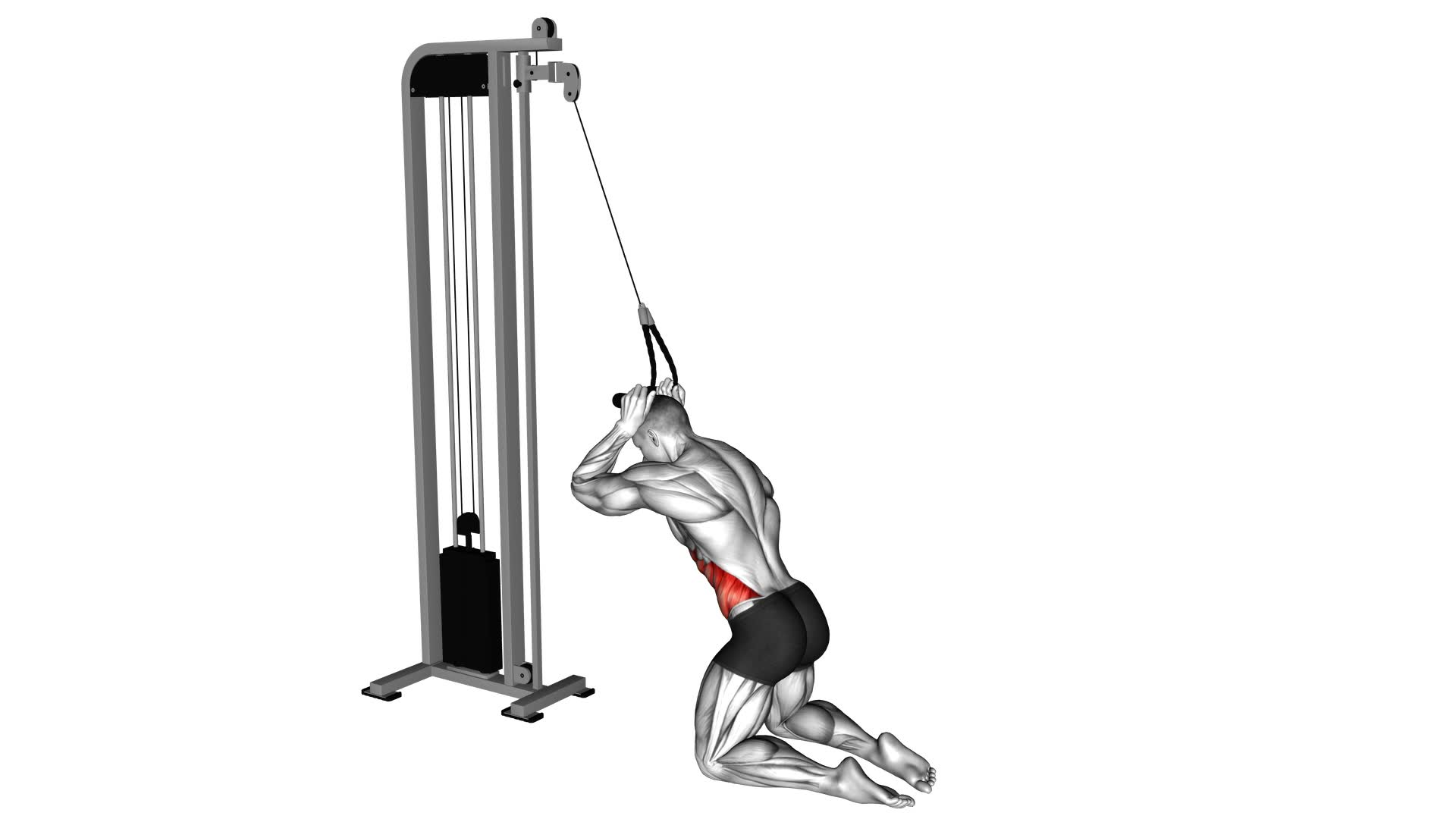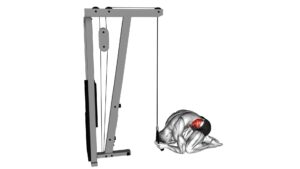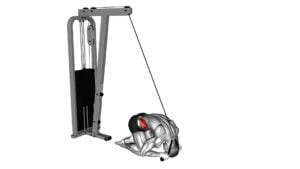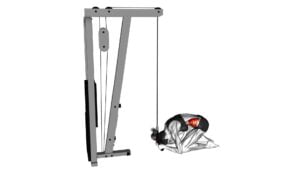Cable Kneeling Side Crunch (male) – Video Exercise Guide & Tips

Get ready to sculpt those abs with the Cable Kneeling Side Crunch!
Watch This Exercise Video
This exercise guide and video will show you the proper setup, correct body positioning, and how to engage those obliques for maximum results.
Avoid common mistakes and discover tips for progression and variation.
Let's get started and achieve those ripped abs you've always wanted!
Key Takeaways
- Proper setup and body positioning are crucial for performing the Cable Kneeling Side Crunch effectively.
- Maintaining proper alignment helps engage core muscles, improve posture, and minimize the risk of injury.
- Achieving optimal posture by aligning the head, neck, and spine, and keeping the shoulders back and down is essential.
- Engaging the obliques through various exercises like side planks, Russian twists, and standing oblique exercises can strengthen and tone these muscles.
Proper Setup and Equipment
To ensure optimal performance and safety, proper setup and equipment are essential for executing the Cable Kneeling Side Crunch exercise.
First and foremost, you need to make sure you have the necessary equipment. The cable machine should have an adjustable pulley system with handles attached. This will allow you to adjust the resistance according to your fitness level. Additionally, you'll need a kneeling pad or mat to provide support and cushioning for your knees.
Once you have the necessary equipment, it's crucial to focus on proper form. Start by attaching the handles to the desired height on the cable machine. Kneel down on the mat, facing the machine, and grab the handles with an overhand grip. Keep your back straight and engage your core muscles.
To perform the exercise, slowly lean away from the machine, bringing your torso and upper body sideways. Crunch your oblique muscles on the side you're leaning towards. Pause for a moment and then return to the starting position in a controlled manner.
Correct Body Positioning
To perform the Cable Kneeling Side Crunch correctly, it's important to focus on proper alignment of your body.
One common mistake is to hunch the shoulders forward, which can strain the neck and shoulders. Instead, aim for optimal posture by keeping your spine straight and engaging your core muscles.
Proper Alignment Importance
Achieving proper body alignment is crucial for maximizing the effectiveness of the Cable Kneeling Side Crunch exercise. The importance of form can't be overstated, as it ensures that you're targeting the correct muscles and minimizing the risk of injury.
When your body is properly aligned, you engage your core muscles more effectively, leading to a stronger and more stable core. This not only enhances your performance in the exercise but also carries over to other activities in your daily life.
Additionally, proper alignment helps maintain good posture, reducing the strain on your spine and preventing back pain.
Common Positioning Mistakes
To achieve proper body positioning during the Cable Kneeling Side Crunch, make sure to be mindful of your alignment and avoid common positioning mistakes. Here are some tips for improvement:
- Avoid leaning forward: Keep your torso upright throughout the exercise to engage your obliques effectively.
- Don't pull with your arms: Remember, the focus should be on contracting your side muscles, not pulling with your arms. Use your core to initiate the movement.
- Maintain a stable base: Keep your knees firmly planted on the ground and your feet shoulder-width apart to ensure stability and prevent any unwanted movement.
- Engage your core: Prioritize engaging your core muscles by pulling your belly button towards your spine. This will help stabilize your body and maximize the effectiveness of the exercise.
By avoiding these common mistakes and following these tips, you can improve your body positioning during the Cable Kneeling Side Crunch and achieve optimal results.
Now, let's move on to the next section and discuss how to achieve optimal posture.
Achieving Optimal Posture
Make sure you consistently maintain proper body positioning for optimal posture during the Cable Kneeling Side Crunch. Proper posture is crucial for maximizing the benefits of this exercise.
Start by aligning your head, neck, and spine in a straight line. Engage your core muscles and keep your shoulders back and down. Avoid hunching or rounding your shoulders.
Additionally, focus on proper breathing throughout the exercise. Inhale deeply as you prepare to crunch to the side, and exhale as you contract your obliques.
By maintaining optimal posture, you enhance the effectiveness of the exercise, target the correct muscles, and reduce the risk of injury.
Engaging the Obliques
To effectively engage your obliques, incorporate side plank variations into your workout routine. These exercises target the muscles on the sides of your torso, helping to strengthen and tone your waistline.
Russian twists are another effective technique to engage your obliques, as they involve twisting your torso from side to side while holding a weight or medicine ball.
Lastly, standing oblique exercises, such as side bends or cable woodchoppers, can help you build strength and definition in your oblique muscles.
Incorporate these exercises into your routine for a well-rounded oblique workout.
Side Plank Variations
Engage your obliques with various side plank variations. Side plank exercises are an effective way to target and strengthen your oblique muscles, which are important for stability and rotational movements. Here are four variations to add to your workout routine:
- Side Plank with Leg Lift: Start in a side plank position and lift your top leg up towards the ceiling. This variation increases the challenge for your obliques and also engages your hip abductors.
- Side Plank with Reach Through: Begin in a side plank position and reach your top arm underneath your body, extending it as far as you can. This movement targets your obliques while also improving shoulder mobility.
- Side Plank with Knee Tuck: From a side plank position, bring your top knee towards your chest, engaging your obliques as you crunch inwards. This variation adds an extra challenge to your core stability.
- Side Plank with Dumbbell Raise: Hold a dumbbell in your top hand while performing a side plank. Raise the dumbbell towards the ceiling, engaging your obliques and shoulder muscles simultaneously.
Incorporate these side plank variations into your workout routine to strengthen and tone your obliques while improving overall core stability.
Russian Twists Technique
Twist your torso to target and activate your obliques with the Russian twists technique. Russian twists are an effective exercise for strengthening the oblique muscles, which are located on the sides of your abdomen. By twisting from side to side, you engage your obliques, helping to sculpt a defined waistline and improve core stability.
One of the main benefits of Russian twists is their ability to improve rotational strength and flexibility. This can be beneficial for athletes participating in sports that involve twisting movements, such as golf, tennis, or baseball. Additionally, Russian twists can help improve posture and balance, as they require stability and control throughout the movement.
If you're looking for alternatives to Russian twists, you can try exercises such as side plank rotations, bicycle crunches, or woodchoppers. These exercises also engage the obliques and provide a similar rotational movement.
Incorporating Russian twists into your workout routine can help you build a strong and stable core while targeting your obliques. Remember to maintain proper form, engage your core muscles, and breathe throughout the exercise for optimal results.
Standing Oblique Exercises
Continue targeting and activating your obliques with standing oblique exercises that will help strengthen your core and improve stability. Here are four standing oblique exercises that you can incorporate into your workout routine to engage your obliques and reap the benefits of oblique training:
- Standing Side Crunch:
- Stand with your feet shoulder-width apart
- Raise one arm overhead while bending to the opposite side
- Engage your obliques as you return to the starting position.
- Standing Oblique Twist:
- Stand with your feet hip-width apart
- Hold a dumbbell or a medicine ball
- Rotate your torso from side to side
- Engage your obliques with each twist.
- Standing Wood Chop:
- Stand with your feet shoulder-width apart
- Hold a weight or a resistance band
- Start with the weight at one side of your body
- Rotate your torso while bringing the weight diagonally across your body.
- Standing Side Plank:
- Start by standing with your feet hip-width apart
- Lift one leg off the ground and extend it to the side
- Simultaneously raise the opposite arm overhead
- Engage your obliques and hold the position for a few seconds before switching sides.
Incorporating these standing oblique exercises into your routine won't only strengthen your core but also improve your overall stability and posture. Let's get those obliques working!
Executing the Cable Kneeling Side Crunch
How can you properly perform the Cable Kneeling Side Crunch? This exercise is a great way to target your oblique muscles and build a strong core.
To execute the Cable Kneeling Side Crunch correctly, start by setting the cable machine at waist height and attaching a D-handle. Kneel down with your side facing the machine and grab the handle with your top hand. Keep your elbow bent and your hand close to your ear.
Engage your core and slowly crunch down towards the floor, bringing your elbow and knee together. Make sure to keep your back straight and avoid leaning forward or backward. Pause for a moment at the bottom of the movement and then slowly return to the starting position. Repeat for the desired number of reps and then switch sides.
To improve your form, focus on maintaining control throughout the movement and avoid using momentum to swing your body. Keep your movements slow and controlled to really target those obliques.
Now, let's move on to common mistakes to avoid.
Common Mistakes to Avoid
To ensure proper form and maximize the effectiveness of the Cable Kneeling Side Crunch, it's important to be aware of common mistakes to avoid. By achieving proper form and avoiding injury, you can make the most out of this exercise and see better results.
Here are four common mistakes to watch out for:
- Using too much weight: It can be tempting to go heavy, but using excessive weight can compromise your form and increase the risk of injury. Start with a weight that allows you to maintain proper form throughout the exercise.
- Not engaging your core: The Cable Kneeling Side Crunch is primarily a core exercise, so it's crucial to engage your abdominal muscles throughout the movement. Focus on tightening your abs and using them to initiate the crunch.
- Rounding your back: Keep your back straight and avoid rounding your spine during the exercise. This helps to target your obliques effectively and prevents strain on your lower back.
- Rushing through the movement: Take your time and perform each repetition with control and precision. Avoid rushing or using momentum to swing the weight. Slow and controlled movements will yield better results and reduce the risk of injury.
Tips for Progression and Variation
To progress and vary your Cable Kneeling Side Crunch, you can incorporate different equipment and modifications. Here are some progression tips and variation ideas to challenge yourself and keep your workouts interesting.
Firstly, you can increase the resistance on the cable machine. Gradually increase the weight you're using to make the exercise more challenging. This will help to strengthen your oblique muscles even further.
Another way to progress is by using different attachments on the cable machine. Instead of using the rope attachment, you can try using a single handle or a straight bar. This will change the angle and intensity of the exercise, targeting your muscles in a slightly different way.
You can also try incorporating instability into the exercise. Instead of kneeling on a stable surface, you can kneel on a stability ball or a balance pad. This will engage your core muscles even more as you work to stabilize yourself during the exercise.
Lastly, you can add a twist to the movement. Instead of bringing your elbow towards your hip, you can bring it across your body to the opposite hip. This will engage your obliques in a different way and add a rotational component to the exercise.
Frequently Asked Questions
How Many Repetitions Should I Do for the Cable Kneeling Side Crunch Exercise?
To get the most out of the cable kneeling side crunch exercise, it's important to find the right repetition range for you. This will depend on your fitness level and goals.
Start with a moderate range, like 8-12 reps per set. As you get stronger, you can increase the number of reps or try different variations to challenge yourself.
Remember to always listen to your body and adjust the repetitions accordingly. Keep pushing yourself and you'll see progress!
Can I Perform the Cable Kneeling Side Crunch Exercise Without Using a Cable Machine?
Yes, you can perform the cable kneeling side crunch exercise without using a cable machine. There are alternative exercises that can target the same muscle groups.
However, it's important to note that using a cable machine offers unique benefits such as adjustable resistance and targeting specific muscles.
If you don't have access to a cable machine, you can try other exercises like the standing side crunch or the dumbbell side bend to work your obliques effectively.
Is It Necessary to Warm up Before Doing the Cable Kneeling Side Crunch Exercise?
Before diving into the cable kneeling side crunch exercise, it's essential to warm up your muscles. Warming up helps increase blood flow, flexibility, and reduces the risk of injury. It prepares your body for the workout ahead and enhances your performance.
If you don't have access to a cable machine, you can try alternatives like standing side crunches or oblique twists with a medicine ball.
Can I Incorporate Weights or Resistance Bands Into the Cable Kneeling Side Crunch Exercise for Added Intensity?
Yes, you can definitely incorporate weights or resistance bands into the cable kneeling side crunch exercise to increase the intensity. By adding weights or resistance bands, you're challenging your core muscles even more and helping them get stronger.
This variation of the cable kneeling side crunch exercise won't only target your obliques but also engage other muscles in your core, giving you a more effective workout.
How Often Should I Include the Cable Kneeling Side Crunch Exercise in My Workout Routine for Optimal Results?
To achieve optimal results and maximize the effectiveness of your workout, it's important to determine the right frequency for including the cable kneeling side crunch exercise. By regularly incorporating this exercise into your routine, you can target and strengthen your oblique muscles.
However, it's crucial to listen to your body and avoid overtraining. Start by adding this exercise 2-3 times a week, and gradually increase the frequency as your fitness level improves.
Conclusion
Incorporating the cable kneeling side crunch into your workout routine can be a great way to target and strengthen your obliques. By following the proper setup and technique, you can effectively engage these muscles and avoid common mistakes.
Remember to start with a weight that challenges you but allows for proper form. With dedication and consistency, you can progress and vary this exercise to continue challenging your obliques and achieving your fitness goals.
Keep pushing yourself and enjoy the results!

Author
Years ago, the spark of my life’s passion ignited in my mind the moment I stepped into the local gym for the first time. The inaugural bead of perspiration, the initial endeavor, the very first surge of endorphins, and a sense of pride that washed over me post-workout marked the beginning of my deep-seated interest in strength sports, fitness, and sports nutrition. This very curiosity blossomed rapidly into a profound fascination, propelling me to earn a Master’s degree in Physical Education from the Academy of Physical Education in Krakow, followed by a Sports Manager diploma from the Jagiellonian University. My journey of growth led me to gain more specialized qualifications, such as being a certified personal trainer with a focus on sports dietetics, a lifeguard, and an instructor for wellness and corrective gymnastics. Theoretical knowledge paired seamlessly with practical experience, reinforcing my belief that the transformation of individuals under my guidance was also a reflection of my personal growth. This belief holds true even today. Each day, I strive to push the boundaries and explore new realms. These realms gently elevate me to greater heights. The unique combination of passion for my field and the continuous quest for growth fuels my drive to break new ground.







